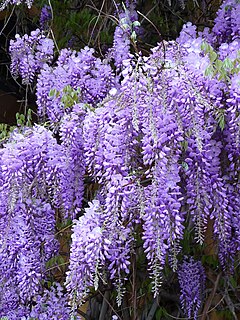
Wisteria is a genus of flowering plants in the legume family, Fabaceae (Leguminosae), that includes ten species of woody twining vines that are native to China, Japan, Korea, Vietnam, Southern Canada, the Eastern United States, and north of Iran. They were later introduced to France, Germany and various other countries in Europe. Some species are popular ornamental plants.

Melastomataceae is a family of dicotyledonous flowering plants found mostly in the tropics comprising c. 175 genera and c. 5115 known species. Melastomes are annual or perennial herbs, shrubs, or small trees.

Tibouchina is a neotropical flowering plant genus in the family Melastomataceae. Species of this genus are subshrubs, shrubs or small trees and typically have purple flowers. They are native to Mexico, the Caribbean, and South America where they are found as far south as northern Argentina. Members of this genus are known as glory bushes, glory trees or princess flowers. The name Tibouchina is adapted from a Guianan indigenous name for a member of this genus. A systematic study in 2013 showed that as then circumscribed the genus was paraphyletic, and in 2019 the genus was split into a more narrowly circumscribed Tibouchina, two re-established genera Pleroma and Chaetogastra, and a new genus, Andesanthus.
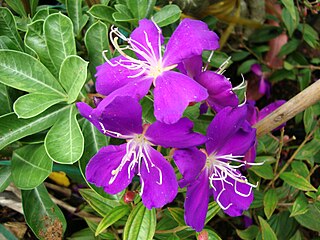
Pleroma semidecandrum, synonym Tibouchina semidecandra, the princess flower, glory bush, or lasiandra, is a flowering plant in the family Melastomataceae, native to southeast Brazil.

Plant collecting is the acquisition of plant specimens for the purposes of research, cultivation, or as a hobby. Plant specimens may be kept alive, but are more commonly dried and pressed to preserve the quality of the specimen. Plant collecting is an ancient practice with records of a Chinese botanist collecting roses over 5000 years ago.

Pleroma elegans, synonym Tibouchina elegans, is an ornamental plant in the family Melastomataceae.

Pleroma heteromallum, synonyms including Tibouchina grandifolia and Tibouchina heteromalla, known by the common name silverleafed princess flower in English, is a species of evergreen flowering plant in the family Melastomataceae. It is native to French Guiana, Bolivia and Brazil.

Pleroma raddianum, synonyms including Pleroma pulchrum(Cham.) Triana and Tibouchina pulchra, is a plant species in the family Melastomataceae.

Pleroma urvilleanum, synonym Tibouchina urvilleana, is a species of flowering plant in the family Melastomataceae, native to Brazil.

Pleroma mutabile, synonym Tibouchina mutabilis, is an evergreen tree with an open crown that grows in Brazil, mainly at the Serra do Mar zone. Also known as glory bush in Australia, where it is a popular ornamental plant. In Brazil, it is named manacá-da-serra.
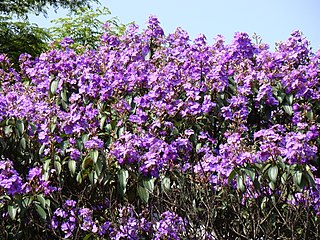
Pleroma granulosum, synonym Tibouchina granulosa, is a species of tree in the family Melastomataceae. It is also known as purple glory tree or princess flower. It is native to Bolivia and Brazil. Because its purple-flowers bloom for most of the year, this tree is often used for gardening in Brazil, where is known by the name quaresmeira.

Pleroma is a genus of flowering plant in the family Melastomataceae, native from Puerto Rico and the Leeward Islands to tropical South America.
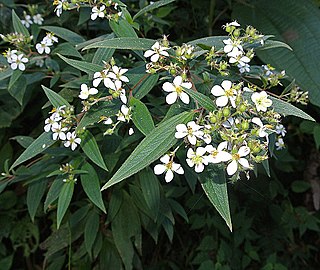
Chaetogastra longifolia is a species of flowering plant in the family Melastomataceae, native to Mexico through the Caribbean to northern South America. It has many synonyms, including Tibouchina longifolia. It was first described in 1797 by Martin Vahl as Rhexia longifolia.

Chaetogastra mollis is a species of flowering plant in the family Melastomataceae, native to western South America. It was first described by Aimé Bonpland as Rhexia mollis in part of Monographia Melastomacearum, volume 2, published in 1808. Its synonyms include Tibouchina mollis.
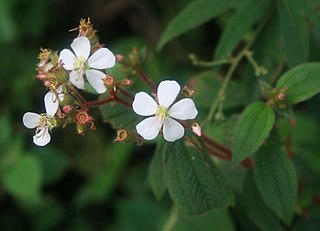
Chaetogastra ciliaris is a species of flowering plant in the family Melastomataceae, native to Colombia, Costa Rica and Ecuador. It was first described as Meriania ciliaris by Étienne Ventenat in 1807. Its synonyms include Tibouchina ciliaris.

Chaetogastra gracilis is a species of flowering plant in the family Melastomataceae. It is native to much of South America, from Venezuela in the north to northeast Argentina in the south. It was first described in 1823 by Aimé Bonpland as Rhexia gracilis. Its synonyms include Tibouchina gracilis.

Pleroma francavillanum is a species of flowering plant in the family Melastomataceae, native to Brazil. It was first described by Alfred Cogniaux in 1885 as Tibouchina francavillana.
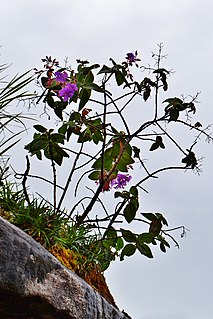
Pleroma pereirae is a species of flowering plant in the family Melastomataceae, native to Brazil. It was first described in 1961 as Tibouchina pereirae.

Chaetogastra clinopodifolia is a species of flowering plant in the family Melastomataceae, native to south and southeastern Brazil. It was first described by Augustin de Candolle in 1828. One of its synonyms is Tibouchina clinopodifolia.
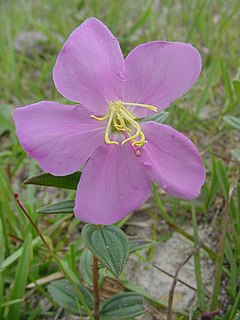
Pleroma asperius is a species of flowering plant in the family Melastomataceae, native to Brazil. It was first described by Adelbert von Chamisso in 1834 as Lasiandra asperior. One of its synonyms is Tibouchina asperior.




















